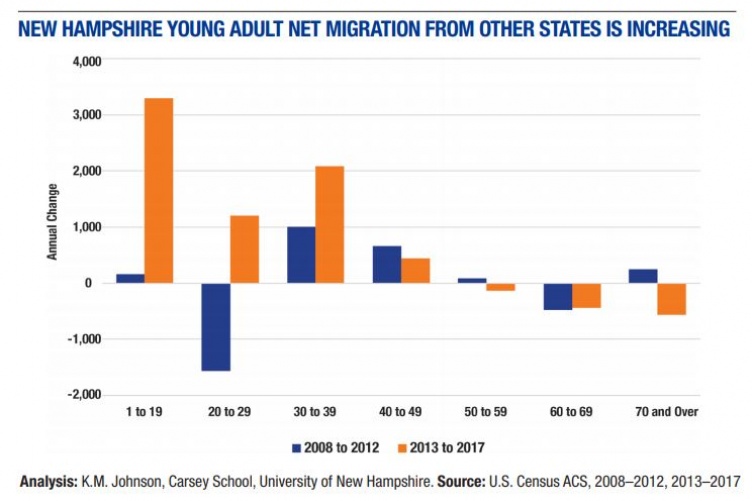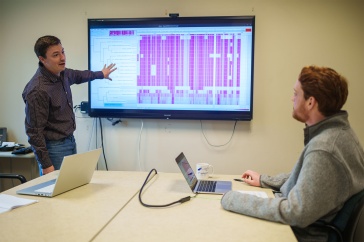
More younger people moved to New Hampshire from other parts of the country in recent years, a substantial shift in demographic trends seen during the Great Recession and its immediate aftermath, according to new research from the NH Agricultural Experiment Station and Carsey School of Public Policy at the University of New Hampshire.
“I knew the state was gaining migrants again, but I was surprised that the gains were so great for young adults. The new data indicate that New Hampshire is gaining modest numbers of migrants from other states and that gains have been most significant among those in their 20s and 30s and their children,” said Ken Johnson, senior demographer with the Carsey School and researcher with the NH Agricultural Experiment Station.
“The primary reason for the recent upturn in migration to New Hampshire appears to be the diminishing influence of the Great Recession on migration. New Hampshire and many other states that have histories of net migration gain saw those migration gains diminish as the Great Recession impacted the country from 2008 to about 2012. As the recession waned, migration has picked up again in New Hampshire and other states like it. Because New Hampshire tends to attract better-educated people in migration exchanges, the state has gained considerable intellectual capital from migration,” Johnson said.
According to Johnson’s analysis of new U.S. Census Bureau Estimates, New Hampshire received a significant net inflow of people from other U.S. states between 2013 and 2017. The average annual domestic migration gain was 5,900 between 2013 and 2017. In contrast, only about 100 more people moved to New Hampshire than left it for other U.S. destinations annually during the Great Recession and its aftermath between 2008 and 2012.
The transformation was greatest among those in their 20s, who had an average annual migration gain of 1,200 between 2013 and 2017 compared to an average loss of 1,500 annually from 2008 to 2012. Among those in their 30s, the net annual migration gain nearly doubled during the same period, while the net inflow of those 40 to 49 diminished slightly. As more family age adults migrated to New Hampshire, their children fueled a significant increase in the net influx of those under age 20.
In contrast, among those age 50 and over, the net outflow of people from the state increased slightly. Modest immigration from other countries at all ages supplemented the domestic migration gains analyzed here. These recent domestic and immigrant migration gains are both modest, but they provide additional human and social capital to a state challenged by an aging workforce and population.
“New Hampshire faces significant challenges because its work force and population are aging. These data suggest that the state is gaining migrants from other U.S. states. Many of these migrants are in the family stage of the life-cycle and will contribute to the social and economic capitol of the state. New Hampshire’s recent migration gains are modest but are important to a state with relatively few births and a growing number of deaths,” Johnson said.
Johnson’s research aims to provide factual, up-to-date information on recent New Hampshire demographic trends to help planners and policy-makers make informed decisions about the state’s future.
This material is based upon work supported by the NH Agricultural Experiment Station, through joint funding of the National Institute of Food and Agriculture, U.S. Department of Agriculture, under multi-state award number 1013434, and the state of New Hampshire. It also was supported by the researcher’s Andrew Carnegie Fellowship and the Carsey School. It is presented in the Carsey School brief More Young Adult Migrants Moving to New Hampshire From Other U.S. Locations.
Founded in 1887, the NH Agricultural Experiment Station at the UNH College of Life Sciences and Agriculture is UNH’s original research center and an elemental component of New Hampshire's land-grant university heritage and mission. We steward federal and state funding, including support from the USDA National Institute of Food and Agriculture, to provide unbiased and objective research concerning diverse aspects of sustainable agriculture and foods, aquaculture, forest management, and related wildlife, natural resources and rural community topics. We maintain the Woodman and Kingman agronomy and horticultural research farms, the Macfarlane Research Greenhouses, the Fairchild Dairy Teaching and Research Center, and the Organic Dairy Research Farm. Additional properties also provide forage, forests and woodlands in direct support to research, teaching, and outreach.
-
Written By:
Lori Tyler Gula, PhD | NH Agricultural Experiment Station | lori.gula@unh.edu | 603-862-1452

















































